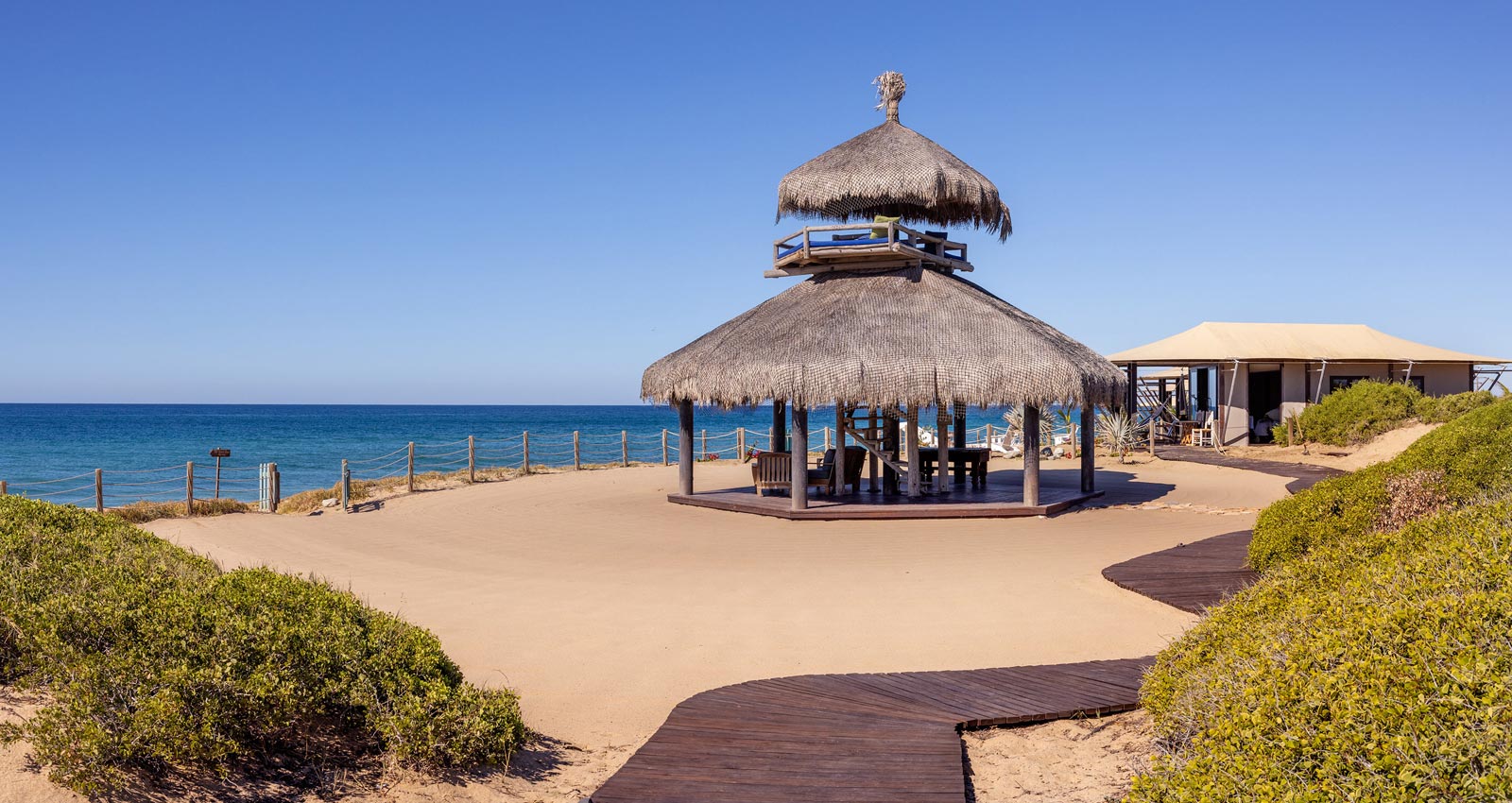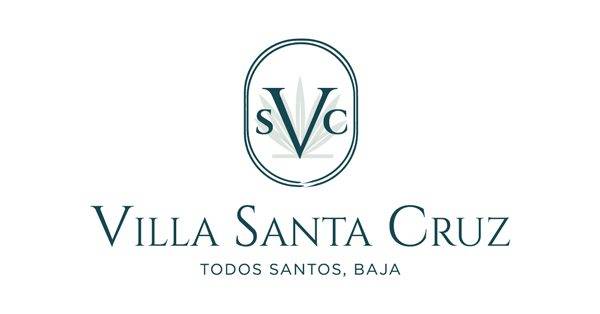We are proud to post the next installment in the adventure of Villa Santa Cruz. If you have not yet read the first entry about how Matt & John found the land, check it out here – Blog Post #1: The Journey Begins! Buying the Property (2001 – 2002). Happy Reading!
The Lettuce Debacle and Breaking Ground on the Villa (2002 – 2003)
Matt and John were deep in it. It was September 2002 and they were now the proud owners of a very raw 45 acre parcel of land that needed work. It had no infrastructure, no easy way to access the beach from the road, no shelter, no nothing. They had to start at the very beginning, but lacked the resources, connections and know-how to move forward and develop the land. After tackling a few minor projects at the well on their own – cleaning tree roots out by hand, and covering the water tower (known in Spanish as a pila – this is the big concrete tower you see today at the front gate) with a palapa roof – they then focused on running basic underground piping up to their “home” – the Airstream Trailer on the Dune that Matt’s parents helped tow down the length of the Baja Peninsula just a few weeks before. They fondly called it “Hobo Heaven.”
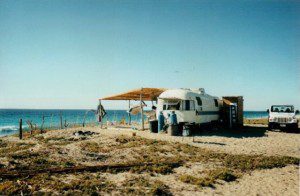
Matt was a frequent visitor at Richard’s (the Natural Born Realtor) real estate office. Under the guise of stopping by to ask Richard for recommendations for plumbers and electricians, he would linger in the office chatting with the lovely young front desk girl, Maria. Matt and Maria soon started spending many hours together and quickly became a couple (much to the dismay of other young men in Todos Santos who were waiting their turn to date her).
After spending a few weeks getting through their basic well projects and clearing the land of years of accumulated brush and overgrowth, they resumed traveling back and forth between Todos Santos and San Diego, continuing to work on home remodels as their main source of income. Starting a new home rehab project in Mission Hills, they took on two partners eager to break into the flipping business. The new guys put up the money while Matt and John contributed their remodeling expertise. Essentially homeless while in San Diego, Matt and John slept on the floor of one of the partner’s homes whenever they were up in San Diego to work.
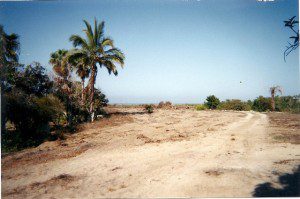
Always eager to get back to Todos Santos (especially so Matt could see Maria), Matt and John became fast friends with Maria’s family, the Davilas. The Davilas were well-connected, entrenched in the community, and also spoke English (a huge plus for Matt and John’s broken Spanish). Matt and John were grateful for the family’s friendship on many levels – the Davilas introduced them to the Todos community, put them in touch with local laborers to work on the property, and, most importantly, gave them a sense of belonging and “family” in this new town.
Over the next month, one of Maria’s brothers, Gerardo, just a 22 year old kid, repeatedly commented to Matt and John that they should consider farming their land. With 45 acres of rich soil, abundant water rights and a history of successful farming at Rancho Santa Cruz, he insisted it would be a natural step for them. Before these discussions with Gerardo, Matt and John had not given much thought to farming. In fact, they were so overwhelmed by scraping by on little funds and tackling small basic projects on the property that a large scale venture had not even crossed their minds. But, Gerardo was persistent, as young kids with big ideas often are. He would visit Matt and John in the evenings to watch the sunset over cervezas and recount telephone conversations he had had with his uncle in Mexico City, a farming expert. He explained that his uncle had big-time connections to food distributors in mainland Mexico and would easily be able to sell any product that grew at Rancho Santa Cruz. He promised that profits would be high, assuring them that farming would be an easy way to capitalize on their investment in the land. After all, he promised that the hardest part of farming was procuring the land and the water, and since Matt and John had so much of both, the rest would be a cinch. To further ease any concerns, Gerardo proposed that he would personally manage the farm operations, reducing Matt and John’s time commitment, freeing them up to continue to travel to San Diego.
Whether it was due to the sound of easy money, the cool taste of amber Pacificos, or, most likely, their absolute naïveté, Gerardo and his farming ideas were starting to sound sensible. Not only did Matt and John trust their deepening relationship with the Davila family and feel secure that they could depend on their support and advice, but they wholeheartedly believed Gerardo when he said they were already one step ahead by owning the land and water. Of course that must be the hardest part – you definitely cannot farm without either land or water. How hard could growing plants actually be? Wouldn’t the seeds do most of the work on their own? Matt and John agreed to be equal partners with Gerardo, shook his hand, and starting daydreaming about lush green fields and cold hard cash.
Gerardo quickly got busy with the details of the farm. With hot, humid and wet summers, the growing season in Todos Santos starts in October/November, at summer’s end, and lasts until the weather starts to warm up again, usually June/July. By the time Matt and John were on board to farm, the calendar was creeping into November 2002 and time was slipping by.
They had decided to farm both the west and east sides of the property– close to all 45 acres of Rancho Santa Cruz – with two different crops: iceberg lettuce on the west side and poblano chiles on the east side. Matt and John knew that poblano chiles are a staple of the Mexican diet (think chile rellenos) and grow heartily in Baja, as evidenced by the many other poblano chile fields seen in Todos Santos and Pescadero. The prior year’s record high price for chiles ($13 pesos/kilo) made it an obvious choice. They reasoned that even if the price per kilo dropped more than half (to $6 pesos/kilo), they would still come out ahead. Assured by such reasonable profit calculations, they figured that poblano chiles were a sure bet.
On the west side, Gerardo originally planned to grow tomatoes, but with each passing day, the ideal window for tomatoes was disappearing and they could not afford the number of stakes needed to farm tomatoes on such a large scale – they would have to plant something else and save tomatoes for next year. As a substitute for the tomatoes, Gerardo proposed that they plant iceberg lettuce since no one else was growing it in Baja. Without much experience to bring to the discussion, Matt and John agreed, believing it to be a good business opportunity.
Still lacking a proper irrigation system but needing to get their seeds in the ground, they germinated thousands of seeds in trays that they could water by hand. With this small respite in the timeline, they had just a few weeks to run pipes and drip tape throughout the property and fortify the well pump to ensure that water would reach all the seedlings they would soon transplant. After running the calculations, they were amazed at the staggering expense of the material and labor costs of the irrigation project. Luckily, Gerardo’s connections came through and the Mexican government gave them a generous farm subsidy, allowing them to quickly set up the proper infrastructure. Impressed by Gerardo’s determination and success with the subsidy, Matt and John felt confident that they had made the right choice in partnering with him.
When the iceberg lettuce seedlings were starting to sprout in the trays, Matt and John had dinner and drinks in town one night and struck up a conversation with a man named Pierre. Coincidentally, Pierre was a lettuce farmer in Salinas, California, a region known as “the Salad Bowl of the World” because it produces most of the salad greens consumed in the United States. Matt and John were proudly telling Pierre about their Baja lettuce crop when they saw a disconcerting look cross his face. Pierre quickly interrupted to convince them, without mincing words, to immediately abandon their lettuce crop. He forewarned that the Baja climate was not suitable for growing iceberg lettuce and they should cut their losses now rather than risk the whole growing season. When Matt and John protested and informed him that they already had thousands of seeds blooming in trays, Pierre bluntly advised them to “stop watering and let the plants die.”
What were they to do now? They had advice from a true expert in the lettuce game vehemently warning them against continuing their crop, yet they were so emotionally connected to Gerardo and his farming optimism that they had lost all objectivity. Guided by their hearts and confident in their luck so far in Mexico, they put their money on Gerardo and let it ride. In just a few days, they had transplanted 230,000 heads of lettuce on almost 20 acres on the west side of the road, and 200,000 poblano chile plants on 20 or so acres on the east side of the property. Go big or go home.
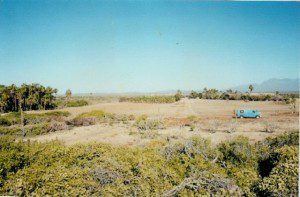
At the same time they were starting the farm, one of their remodeled homes in San Diego sold and they benefited from a financial windfall. Suddenly flush with cash, they decided to start construction on a home on the property (which would one day become Villa Santa Cruz). From the beginning, their “plan” for the home was always more of a romantic, vague, “shoot from the hip” rough sketch, than one based on forethought and prudence. They favored quick drawings on cocktail napkins and a “surely we’ll have enough money” attitude over architectural blueprints and calculated budget proposals. In so many words, they decided to get started and figure it out later.
The thought of designing a custom home on raw land was, at first, overwhelming – the possibilities were endless. They were not bound by lot size, homeowners’ association restrictions, city codes/regulations, and, naively, were not too concerned with the budget. Occasionally realistic, they did know it would be best to pool their resources and build one large home, rather than a separate home for each of them. As they really started to think about what they wanted the home to be, a vision of family took shape. Matt was so in love with his girlfriend and her whole family that he envisioned it would be a large family home for his future wife and kids, with plenty of room for “Uncle John.”
This basic intention for the home reigned in their unfettered thoughts and organized their creativity. With this “family compound” ideal in mind, coupled with their frustration of living in a tiny tin can of an Airstream trailer for months on end, the most important thing to them in the design was space. They greedily decided on 14 foot ceilings and a ground floor footprint measuring 12 meters by 16 meters, giving them over 2,000 square feet on the first floor alone. They would have three levels, 4 bedrooms, and 5 bathrooms. They had the space to do it, so why not go for it? Of course, they also wanted the home to be as near to the ocean as possible, but took great care to pick a site that would not interfere with the integrity of the dunes. Pacing off the footprint on the land and setting up ladders to check the views at different elevations and angles, they positioned the home due south, taking advantage of ocean views and optimal sun exposure (for their future solar system).
With basic decisions made, many of the design elements came easily. They paged through Mexican architectural books and fell in love with the old Hacienda style – they had to have a fountain in the center of the house with wrought-iron railings surrounding it. They wanted grand archways and a covered patio area, all reminiscent of Old Mexico. Their minds were racing with ideas and they were itching to break ground and get the project underway. They felt so fortunate that Gerardo and the Davila family, who they trusted completely, were also construction contractors and had time to take on a new project.
Without a clear set of building plans or the funds it would take to see the house built to completion, Matt and John could not afford to bid the project (usually, the avenue used to garner the best price from a contractor). While they had a comfortable construction budget from the proceeds of the San Diego house sale, they were counting on the success of the lettuce/poblano chiles to carry them through to the end of the project and beyond. Their only option was to tackle the construction bit by bit, paying the contractor on a weekly basis for time and materials plus a percentage. Matt and John never thought twice about the arrangement with the Davilas –they were confident that their “family” relationship and the love and respect between them would guide their interaction and prevent one from taking advantage of the other.
With a basic outline of the work drawn, the crew got to work on the foundation. The subterranean excavation and concrete work was enormous and consumed a huge part of their budget. While it was disappointing to see so much of their cash literally sunk into the ground, Matt and John loved knowing that the home would stand up to any future storm or hurricane. In fact, seeing the project underway and envisioning the house as a finished product only encouraged them to dream bigger.
They loved the freedom of being their own architects. As soon as they could draw an idea on a cocktail napkin and get it approved by a structural engineer, it went right into the design, often without regard for the rest of the plan. They were building multiple levels with grandiose architectural features (i.e. elevator shaft, gas lamps, archways), but had no plan for arguably the most functionally important element of the home – the stairs. Not too concerned, they simply left a huge hole in the second floor and figured they could add a staircase later. In the meantime, the workers rigged ladders and a rough dumbwaiter system to access the second level.
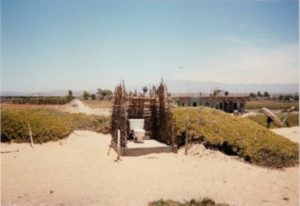
As the calendar changed from March to April (2003), both the farming venture and the home construction appeared to be right on track. The crew was starting to work on the second level of the home, heads of iceberg lettuce were forming beautifully, the chile plants were sprouting up toward the sky, and the land had turned from dull brown soil to verdant green fields. Gerardo was busy managing the farm, ensuring that the crop was properly watered and fertilized, and he also began to search for a buyer for the product. He soon connected with a contact at CCC (now Chedraui), a large supermarket in Cabo San Lucas, and contracted with them to sell their entire supply of Rancho Santa Cruz iceberg lettuce. By this time, the lettuce was just about ready to be picked for market, and Gerardo, Matt and John were thrilled with the potential profit they were going to make from the CCC deal. Not only would they recoup the $30,000 USD they had invested into the farm to cover expenses (i.e. payroll, seeds, fertilizer, etc.), but they would also realize a substantial windfall of almost $80,000 USD on the lettuce alone. They were amazed! For the entire growing season, they had doubted whether or not they could pull it off – not only were they novice farmers, but the risk was enormous (especially after Pierre’s discouraging advice) and they were so dependent on Gerardo. But, looking out over their green fields and seeing the calculations in black and white, they were effectively converted into believers. They would have plenty of money from this crop to continue construction on the Villa and they would be able to do it all again next year. The future had never seemed rosier.
A day or so later, Matt and John, normally accustomed to bright sun waking them up like a spotlight through the trailer windows, were surprised to see a coastal fog rolling in from the ocean over the lettuce fields, dimming the morning light. They could sense a cool change in the air, but thought nothing of it. In fact, they were delighted that the weather was turning cooler – didn’t lettuce thrive in cool climates like Salinas? The cooler temperatures would also make lighter work for the crew picking the lettuce over the next few days.
But, the fog lingered on with an ominous presence over the ocean, and Matt and John’s initial delight turned into apprehension. Walking through the fields as the laborers picked the lettuce heads and boxed them to transport to CCC, Matt and John’s apprehension quickly escalated into outright distress. Reaching to the soil to pick up a few of the lettuce heads, they each felt mushy, almost gelatinous, with an unappetizing brown tinge to the leaves. They knew this was not supermarket quality lettuce and probably barely made the grade as animal feed. But, how was this possible? Just a few days before, the crop was fresh, green and picture perfect and now had suddenly turned rotten.
Gerardo drove the first truckload of brown jelly lettuce to the supermarket CCC and breathed a sigh of relief when the manager handed him a check for the product – maybe the lettuce was not as bad as they thought, after all. The relief was short lived. As Gerardo drove away, his cell phone began to ring incessantly. Anticipating bad news, he reluctantly answered the phone and the manager on the other end informed him that the product was unfit for human consumption, violated the terms of the agreement and demanded that Gerardo return the check. Exasperated at this turn of events, there was nothing to do except honor the contract and give the money back.
In a state of disbelief and utter panic, Matt and John needed to figure out what had happened. The only contact they knew who could answer their questions was the original lettuce expert, Pierre – the one who had fervently urged them to abandon their iceberg seedlings months before. Sitting in their trailer on the dune, John slowly dialed Pierre’s number, and sheepishly admitted that they had completely disregarded his prior advice and gone ahead with their lettuce crop which was now rotting in the fields, just as predicted. For the rest of the phone conversation, John was relatively quiet – all he could do was listen to Pierre, shake his head and rub his forehead in frustration. Pierre explained that iceberg lettuce is rather susceptible to disease and that, from John’s description, it seemed that the crop had succumbed to a new problematic fungus, Phoma Basal Rot, and there was nothing they could do to fix it. The crop was done.
Hanging up the phone, Matt and John did not fully understand the issue– was the rot caused by the cooler coastal fog? Was it wet soil conditions? Did the fungus live in the soil or was it airborne? Ultimately, the answers to these questions did not matter one bit – the crop was destroyed and their lettuce farming business was bankrupt. The expected $80,000 USD profit vanished and they were in the hole $30,000 USD from the farming expenses.
They pinned their last ounce of hope on the poblano chile crop. If they could just get a reasonable price per kilo, they would realize a $60,000 USD profit, which they could use to cover their losses from the lettuce disaster and still put money in their pockets. It would not be the wealth they were hoping for, but it would definitely help take the sting out of the ordeal.
Selling the poblano chiles was an easier task because the buyers essentially came to the growers. Six or seven huge semi-trucks had parked themselves in different areas of Todos Santos and Pescadero, waiting to buy poblano chiles from local farmers. Gerardo and Matt loaded up their first truckload of chiles and drove it into town to sell to the waiting trucks. Negotiating with the merchants brought them to their knees. They were astounded at the offered price – just $2 pesos/kilo – one of the lowest in recent history. The crop was basically worthless. How was this even possible?
Encouraged by last year’s record high price of $13 pesos/kilo, apparently every farmer in the area had decided to grow poblano chiles. Principles they had learned in high school economics class flooded back – when the market is oversaturated with supply, a surplus occurs, leading to a lower price. And this year, the price was really low, so low that farmers could barely afford to hire laborers to pick the chiles off the vines; in some cases it was more cost effective to hire tractors to disc the crop back into the soil rather than pick the chiles and take them to market. Gerardo and Matt bounced from buyer to buyer, finally negotiating a price of $2.8 pesos/kilo, earning them just $4,000 USD for their entire chile field. This was a far cry from the $140,000 USD in profit they expected to earn from both crops, leaving them with an overall loss of $26,000 USD. Matt and John felt a huge range of emotion – they were devastated, incredulous, dumbfounded, speechless, enraged, panicked and humiliated – all at the same time. The experience cracked the rose-colored glasses they had worn throughout their time in Mexico and the high they had thrived on since purchasing the property was suddenly over.
The farming fiasco was all-consuming and created so much tension in their relationship with Gerardo and the Davila family that it quickly deteriorated and came to an abrupt end. Whether warranted or not, Matt and John felt misled and betrayed by Gerardo’s inexperience and embarrassed that they had let such a novice lead them into financial ruin. These feelings bled over into their construction relationship, prompting them to question material orders, budget transparency and work ethic. Ultimately, out of money and without any foreseeable future income now that the farm had failed, Matt and John had no choice but to stop construction on their home, essentially firing the Davila family contractors. To make matters worse, Matt’s relationship with Maria could not survive the tumultuous episodes with her family and he found himself alone, heartbroken and depressed at the sudden turn of events.
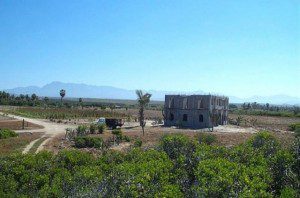
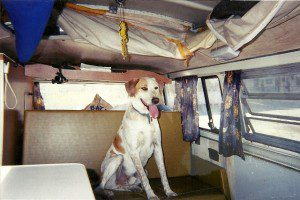
As it seems could only happen in a country song, in the midst of all this turmoil, their dog, Tucker, was tragically killed in a hit and run accident outside the front gate. Wanting Tucker’s soul to live on nearby their future family home, Matt carried the dog’s limp body to a grave dug next to the construction site. Matt and John planted a plumeria tree at the head of his grave (still there today near the parking spaces at the Villa) to honor his spirit. Losing Tucker left them with a crippling sense of loss and emptiness. His death shattered their hearts and was, in effect, an embodiment of so many recent failures and frustrations at Rancho Santa Cruz that it was hard to remember why they even got started in Todos Santos in the first place.
They had reached a low point, to say the least. All the cornerstones they had depended on in Todos had suddenly disappeared: the farm was over, they had lost their way to make a living in Mexico, the construction was stalled for an indefinite amount of time, their “family” connection to the Davilas and Todos Santos was ruined, Matt’s relationship had ended and Tucker was gone. They only thing Matt and John had left to cling to was their friendship, the one constant they could always depend on. This was the rockiest of times and seemed insurmountable, but at least they were enduring the low points together. They had no choice but to forge ahead. With huge farming losses and all their money tied up in the land, they had to be a united front against whatever Mexico would bring them next.
Check back in a few weeks for the next installment in this crazy story!
**We’d like to extend a huge thank you to Matt’s good friend, Jason Doucette, for contributing many of these pictures. This was an era before email and digital photos, so it is difficult to find prints. Jason, thanks for digging through boxes in your storage unit to find these. They bring the story to life!**

